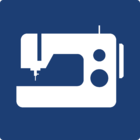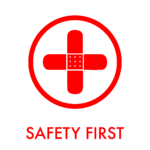Difference between revisions of "Sewing Machine"
| Line 118: | Line 118: | ||
# The needle thread breaks: Check the threading of the needle as it may not be threaded properly. It is also possible that the needle needs to be changed. Learn this skill from one of the sewing volunteers or aces so that you can perform a needle change when needed. | # The needle thread breaks: Check the threading of the needle as it may not be threaded properly. It is also possible that the needle needs to be changed. Learn this skill from one of the sewing volunteers or aces so that you can perform a needle change when needed. | ||
| − | # The needle breaks: Make sure the needle is installed correctly and is tight. Verify you are using the correct | + | # The needle breaks: Make sure the needle is installed correctly and is tight. Verify you are using the correct presser foot. |
# Machine does not run smoothly: Verify the hook race and bobbin holder are free from lint. | # Machine does not run smoothly: Verify the hook race and bobbin holder are free from lint. | ||
| − | # Clearing a thread jam: Because the rotation of the bobbin in the bobbin case is pretty sloppy, thread jams can happen fairly frequently. Use the screwdriver keys that came with the sewing machines to open the needle plate (a.k.a. the throat plate) and access the bobbin case. | + | # Clearing a thread jam: Because the rotation of the bobbin in the bobbin case is pretty sloppy, thread jams can happen fairly frequently. Use the screwdriver keys that came with the sewing machines to open the needle plate (a.k.a. the throat plate) and access the bobbin case. Use the lint brush and tweezers to remove any tangled thread you find. |
==Maintenance== | ==Maintenance== | ||
Revision as of 15:42, 1 February 2024
Make: Janome
Model: 3160QDC
Serial Number: 8H2036666 / 8H2036653
Ace: Sara Wytsma (swytsma23@georgefox.edu).
Location: The Hub
Safety First
Here are some safety instructions for the Sewing Machine. Remember ... SAFETY FIRST!!!
- Sharp Hazard – needles are very sharp and can pierce your skin. Turn off the sewing machine when inserting/removing needles to avoid bumping the foot pedal and moving the needle assembly. Never place your fingers directly underneath the needle.
- Crush Hazard – be aware of all moving parts and keep your fingers away from any pinch points.
- Entanglement – ensure that loose clothing, long hair, or any other dangling/loose items do not become entangled in the machine. Hair that extends below the collar should be tied up.
- Eye Injury – needles can break if they hit a solid object while sewing. The broken tip can fly off and become lodged in your eye. Eye protection is recommended when using the sewing machines.
- Do not sew over pins. This can break or bend the needle.
- Ensure the needle you are using is undamaged before you begin sewing.
- Make sure the needle is installed correctly. Well seated with the needle clamp screw tightened.
- Verify that you are using the correct presser foot. When changing out the presser foot, manually check that the needle’s travel will clear the foot by turning the handwheel one full rotation toward--not away from--you before using the foot pedal.
- Do not run thick fabrics or many layers of fabric through a standard sewing machine. Use the industrial sewing machine for these applications.
- When you finish using the sewing machine, disconnect the power cable and the foot pedal from both the machine and the wall outlet/power strip. Coil the power cable and foot pedal cords neatly, and stow on the free arm beneath the dust cover.
Description
There are currently four Janome 3160 QDC sewing machines available for use in the Maker Hub. This model features 60 different stitch patterns. It has automatic fabric feeding, one hand needle threader, and easy to follow instructions, making it an ideal machine for first time sewers. Some of its more advanced features include buttons for lock stitch, needle up or down, and automatic thread cutting. It has an extension table that can be attached to make sewing larger projects a breeze.
Two machines are kept in the Tool Room on shelf 10. Accessory feet are also kept in the Tool Room, and may be checked out as needed by qualified students. A reference copy of the manual is in the top drawer of the storage unit in the sewing area. There are phone stands in that same drawer for use while following tutorials or reading the copy of the manual available on this page on a phone or tablet. The extension tables for the two machines in the sewing corner are in the third drawer of the storage unit.
Here is an example of this piece of equipment being used.
Documentation
Terminology
- Spool pin - Holder used for thread.
- Bobbin - Cylinder on which is wound thread that comes from beneath the work
- Presser foot - piece of metal that presses the fabric against the feed dogs when sewing.
Training
All information on these specific machines can be found in the User Manual and on the Product Home Page
How to set up the machine. This video shows a similar set up process to our machines, but be sure to compare to the manual.
A quick video on basic stitching techniques:
YouTube is a great resource for learning new things. If you are new to sewing, try watching a few videos to get a general understanding before jumping into sewing.
For more pro tips on sewing visit this website that explains stitch length.
Operation
Winding the bobbin
- Choose your thread. Make sure you find the end before you put the spool of thread on the spool pin. Use a spool cap to hold it in place. Make sure there is no gap between the cap and the spool of thread. The thread being drawn from the spool when sewing can become tangled in any gap and break.
- Follow the diagram on the machine housing in order to fill a bobbin. Place the bobbin on the bobbin winder spindle that is on the right top of the machine. Slide the bobbin winder shaft over to the right to lock it.
- Hold the thread for couple seconds at the beginning as you press the foot pedal gently and slowly. Once it becomes even or uniform, you can let go of the thread and go faster with the foot pedal.
- Cut the thread once you are done and place the bobbin in the bobbin case. (Before you load the bobbin in the bobbin case, cut off the tail that may be hanging from the hole through which you initially threaded the bobbin.) The drop-in bobbin is covered by a plastic cover that you can remove by gently pulling the hook cover release button. Load the bobbin by following the diagram on the plastic cover. Replace the cover.
Threading the machine
- Draw thread from the thread spool and thread the machine by following the directional numbered arrows on the housing of the machine. Make sure the thread is well-seated between the tension discs at the numbered dial and is through the eye of the take-up lever--part 7 in the manual. At the end, thread the needle.
Demonstration
The demonstration will include several steps. Demonstrate you can safely setup the sewing machine, which includes winding the bobbin, threading the machine, and removing/replacing the needle. Finally, sew a mini pillow.
General Procedure
- Wind the bobbin and thread the machine
- Pick two pieces of fabric and place right sides together--the 'pretty' side. Align the raw edges of the two pieces.
- Sew a 1/2 inch to 5/8 inch seam on three sides, using a straight stitch.
- At the beginning and end of each side it's best to shorten the stitch length and stitch off the edge of the fabric. It makes a more durable corner--the bulk can be trimmed out of the corner, too, which makes a cleaner (pointy-er) corner. To change the stitch length: stop sewing; leave the work in place under the presser foot; raise the needle; change the stitch length and resume stitching. Lift the presser foot to remove the work. Break the thread tails on the thread cutter, or clip with scissors.
- Press seams flat, then turn the work right-side out and press. Turn raw edges of the open end to the inside 1/4", and press.
- Stuff your pillow! Sew open side shut by stitching with straight stitch close to pressed edges.
(Note: you can use pins to hold things in place, but you need to remove the pins as you stitch. Never sew over pins. It breaks or bends needles, and can mess up the rotation/timing of the bobbin's oscillations.)
Certification
Complete The Hub - Sewing Machine Module at the link below to gain access to the Sewing Machine. The Maker Hub Canvas course pertains to all facilities and equipment contained in the Maker Hub; simply complete the quizzes for the facilities/equipment you wish to use in the Maker Hub. Please email makerhub@georgefox.edu if you have any questions.
Troubleshooting
There are many different types of problems you can have while using a sewing machine, but here are a few basic problems.
- The needle thread breaks: Check the threading of the needle as it may not be threaded properly. It is also possible that the needle needs to be changed. Learn this skill from one of the sewing volunteers or aces so that you can perform a needle change when needed.
- The needle breaks: Make sure the needle is installed correctly and is tight. Verify you are using the correct presser foot.
- Machine does not run smoothly: Verify the hook race and bobbin holder are free from lint.
- Clearing a thread jam: Because the rotation of the bobbin in the bobbin case is pretty sloppy, thread jams can happen fairly frequently. Use the screwdriver keys that came with the sewing machines to open the needle plate (a.k.a. the throat plate) and access the bobbin case. Use the lint brush and tweezers to remove any tangled thread you find.
Maintenance
General maintenance
Keep the sewing machine clean and free from lint. Make sure to reset the space when you are done sewing.
Specific Maintenance Tasks
| Maintenance Procedure | Frequency | Done By |
|---|---|---|
| Lubricate mechanisms | Semester | Tech |
| Clean machine interior | Monthly | Tech |
| Change the needle | As Needed | Users |


